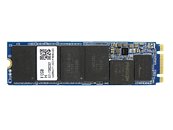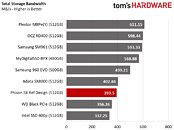Friday, September 1st 2017
New Wave of M.2 SSDs With Phison E8 NVMe PCIe x2 Controllers to Hit Next Month
Phison has been working hard towards bringing to market a new, budget SSD controller in the form of its Phison E8 solution. The controller was designed with the purpose to try and dethrone Intel's 600p solutions from the budget, entry-level NVMe options, through offering increased performance at the same affordable prices. To do this, and so as to decrease power consumption, Phison opted for a PCIe 2x support for the E8 - this means the company is trading burst performance for decreased power consumption. E8-based SSDs are expected in capacities of 128 GB, 256 GB, 512 GB, and 1 TB, with prices lower than the current 600p and Phison's own E7-based products like the MyDigitalSSD BPX.
The Phison E8 controller should still offer plenty of increased performance over a typical HDD, and has been designed to work with 3D NAND technology. even with the firmware in its non-final stages, Tom's Hardware is reporting that the Phison E8's performance is already higher than Intel's 600p and WD's Black PCIe solutions. As we all know, though, firmware optimizations are paramount to SSD controllers' performance, so we can only expect these performance numbers to go up. All in all, it seems we'll have yet another low-cost NVMe SSD solution in the market, though desktop users will likely opt for a PCIe 4x solution, since that environment doesn't care about power consumption as much as a mobile solution would.
Source:
Tom's Hardware
The Phison E8 controller should still offer plenty of increased performance over a typical HDD, and has been designed to work with 3D NAND technology. even with the firmware in its non-final stages, Tom's Hardware is reporting that the Phison E8's performance is already higher than Intel's 600p and WD's Black PCIe solutions. As we all know, though, firmware optimizations are paramount to SSD controllers' performance, so we can only expect these performance numbers to go up. All in all, it seems we'll have yet another low-cost NVMe SSD solution in the market, though desktop users will likely opt for a PCIe 4x solution, since that environment doesn't care about power consumption as much as a mobile solution would.


22 Comments on New Wave of M.2 SSDs With Phison E8 NVMe PCIe x2 Controllers to Hit Next Month
On topic, these should be good drives for laptops. Somewhat increased performance is one thing, but anything to eek out some more battery life is very welcome.
That should be their slogan
Thanks for the heads-up, I changed my mind on how to write the sentence halfway.
I hate phison (already on subconscious level), but if they manage to make it significantly cheaper than 600p and at least as fast as my XP941 - I'll be their #1 fan no matter what others say.:banghead:
It's explained right in the article why they went with PCIe x2. A single PCIe 3.0 lane can carry almost 1GB/s, why exactly would you need x4?
My PC boot time is around ~15s, given that I haven't reinstalled windows in over a year and went through several update cycles, from 1507 to Creators Update. Wake from sleep is near instant.
So, from the end-user perspective using NVME as boot drive - it's not much different from current-gen 960 Evo or Pro.
PCIe x2 may suffer from slower random access times, but in a typical usage scenario it won't make much difference.
Same goes for SATA-III drives: there are no drives which even get close to a theoretical 750MB/s throughput, and the ones that get over 500MB/s usually cost about as much as low/mid NVME.
Also, that number is a combined result from PCMark 8 Storage Test, which includes a variety of mixed workloads. Even Samsung 850 Pro gets somewhere near 300MB/s total throughput, and that's one of the fastest SATA-III SSDs on the market.
So, basically it's about 25% faster than 850EVO, and given the context, hopefully it will cost less than 600p (e.g. definitely cheaper than Samsung SATA SSDs in terms of $/GB)
@Raevenlord, there is also an upcoming E12 and S12 controller series. E12 definitely looks interesting from the performance perspective.
SATA3 indeed has enough bandwidth for virtually any consumer SSD. But NVMe is supposed to have a lower overhead and help when issuing many commands in a short time span. It was hoped to work wonders for 4k random reads at QD1, but in practice it brings a 20% improvement (or less). Which isn't bad, but it's not exactly what was hoped for.
EDIT: I believe this confusion is why I could never get SATA drives to work in my bootable experiments, let alone in a driver!
My main reasons for getting them was sppppeeeeeeed, and less clutter was an added bonus, since I removed all HDD cages and cables, and the SSD I have is mounted on the backplane of my case, on top of the optical drive cage, out of sight :)
But to stay on topic, there is NO way I will go back to x2 devices after enjoying the bandwidth that x4 gives me. Yes, its nice to have a lower-cost option available, but I don't do bottom-of- the-barrel builds, so ya'll can have them if ya wanna.....
So far I haven't encountered a single problem: it's installed as a boot drive on my MSI B150I motherboard, and the heat is not an issue, because this SSD is only used for OS and most frequently used software. Very low-intensity loads.
Most NVME SSDs throttle at 90C or higher, but in real-world consumer applications you won't see those loads (except maybe 3-pass zero formatting or maybe imaging an entire drive several times in a row). Mine stays cool to the touch all the time (can't read exact temps due to an old Samsung S.M.A.R.T. bug).
Speed has definitely improved a lot. I used to have several SSDs, from Kingston V300 and older Crucial drives, to the latest Sandisk X400, and I can tell you this: the transition from SATA to NVME is almost as noticeable as a transition from HDD to SATA SSD. I can't even imagine what kind of startup times to expect from a RAID array of two high-end PCIe 3.0 x4 drives....